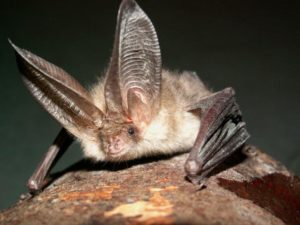The World Around Us:
Bats
Spring is around the corner! With it comes spring cleaning, and we are likely to encounter bats or their nests. It is important to encourage them to remain, and if need be, safely relocated if indoors.
Poor bats! Unfairly maligned in literature, movies, TV, and certainly at Halloween, how many of us are terrified when we find them in our chimneys, barns, or somehow in our homes? Yet without their help controlling the insect population we would be in dire straits, both personally and in the environment at large.
There are 39 species of bats in the United States. One of the most common in New York State is the northern long-eared bat, which is comparatively small, with a wingspan of 3.4 inches. Like most bats in New York, females give birth to one pup in July. They roost with their young among branches in interior forests, and migrate in autumn from the forest canopy to a cave, which can often be shared with other bat species.

Northern long-eared bats, like most bats, have long been appreciated for their diet of primarily insects, providing humans with at least a little relief from pesky bugs. Some have been recorded living as long as 18 years in the wild!
However, such a life span would be a rare occurrence today. Due to white-nose syndrome, the population of most bat species in New York has decreased by at least 90%. The northern long-eared bat was the hardest hit by this fungus and has completely disappeared from many areas, compelling both the state and federal governments to label them as “threatened.”
White-nose syndrome was discovered in 2006 in a cave in Schoharie County, NY. It appears as a white powdery film on the muzzle and wings of infected bats and grows best in lower temperatures, making hibernacula, such as caves, mines, and crevices, threatening to their health. During dormant winter months, a bat’s body temperature drops and immune system is depressed. Unfortunately, this fungus can persist in warmer weather, enabling it to re-infect any surviving bats the following year.
Amazingly, recent research shows that one species of bats has been able to survive — the little brown bat population in New York State appears to be on the rise. This resilient group had a lower fungal growth than those who were in decline. Although reasons for their resilience are unclear, it may be that these bats have developed an immune response or they have a different collection of micro-organisms on their skin to protect them.
While scientists work to understand the causes of the bats’ decline across the country, we can celebrate this glimmer of hope that the eradication of bat populations throughout the state and country may not be the elimination of all bats, who are a very important part of our ecosystem. So…we wish them luck surviving another obstacle besides loss of habitat, disease, and, of course, their undeserved reputation!
NOTE: There are some fascinating youTube channels on bat rescues – one such group is Megabattie.
New York State Humane Association Humane Review, Vol.XXXV, Spring 2020.